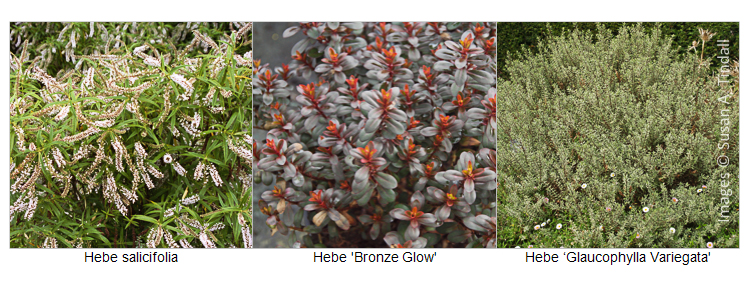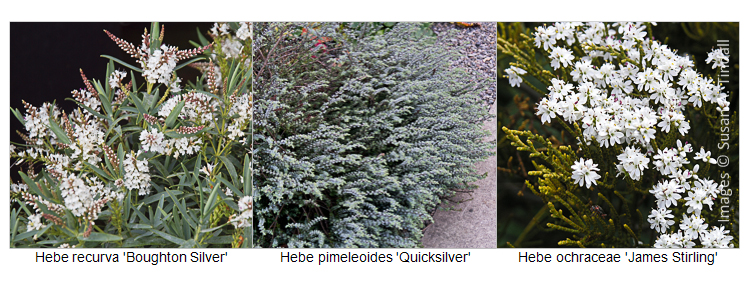Garden centres and online sites usually have a gathering of Hebes. The featured plants are generally small with long shiny leaves that may be green or carry bright, even curious variegation. There are often ‘tussocks’ of flowers in just about every shade but yellow or orange. They are indeed hard to resist, and are ideal subjects for containers on the patio. Surely one can do more with them.
Containers have their uses. They are a good setting for many modern cultivars that have variegated foliage, Hebe ‘Sparkling Sapphires’ for example could be used in a pair of containers set on each side of a pathway. The golden foliage of Hebe ‘Golden Anniversary’ can provide a warm gold backdrop to busy containers that froth with annuals.
They can also look remarkably good planted in a border or as a feature, primarily for foliage interest. Invest in a group of three, choosing plants with a good solid form, such as Hebe ‘Autumn Glory’ with glossy green leaves and purple flowers in August and September. Plant in a triangle set half a metre from each other and this will develop as a striking feature for year round interest. This would contrast well with other variegated and showy plants. If you want just one plant, the willow-like foliage of Hebe salicifolia and its frothy mass of white flowers in summer, is a delight.
Hebes also look surprisingly good planted singly in borders, or round the feet of roses. The rather unattractive rose stems can be completely hidden by a compact Hebe. Try Hebe Bronze Glow = ‘Lowglo’ with its bronzed foliage and blue spring flowers that combine so well with tulips in spring and pink or red roses in summer.
In addition to these lush, leafy Hebes there are other distinctive varieties. For sheltered spots the silvered grey and blue leaves of dainty Hebe ‘Glaucophylla Variegata’ can make an exceptional contribution. Use it as a tall highlight above low-growing herbaceous plants in a sunny spot. Even more exquisite is silvered Hebe pimeleoides ‘Quicksilver’ which has outreaching horizontal branches, wonderful as an edging plant or on a raised bed.

Hebes that have close-textured foliage such as the tight dome of Hebe recurva ‘Boughton Silver’ make a huge contribution to often shaggy and characterful plants in a Mediterranean-style garden. The whipleaf Hebes with their conifer-like branches can make tiny specimens in a rock garden. Hebe ochraceae ‘James Stirling’ a curious shade of burnt gold, is highly distinctive.

Finally, Hebes for winter colour. Many Hebes have foliage that changes colour in cold weather, a valuable asset indeed for those long dull months. If you have space, try the magnificent Hebe ‘Mrs Winder’ coloured red-mahogany in winter, or the smaller Hebe ‘Caledonia’ which is rose-purple is equally good. There are others, worth a bit of research in our Plant Finder, if you have trouble choosing the one among many that are on offer.
Enjoy your Hebes.
Susan A. Tindall

